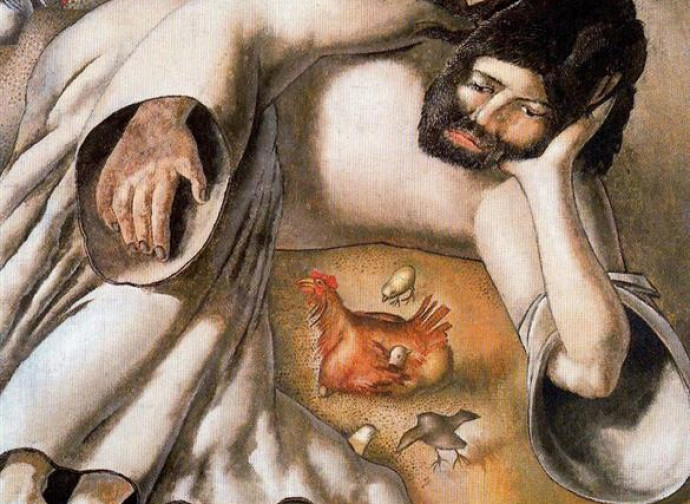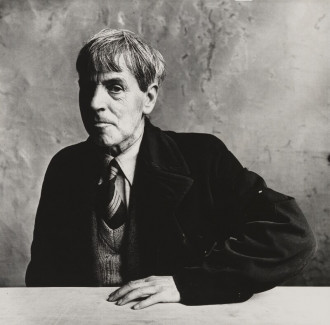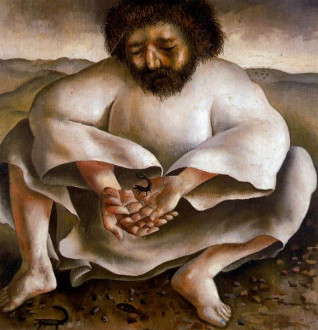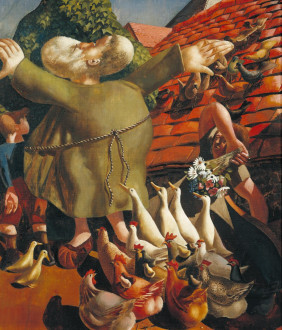Sir Stanley Spencer, a controversial artist in love with Jesus
Sir Stanley Spencer wanted to dedicate a painting to each day Christ spent in the wilderness, with the intention of exhibiting one every day of Lent, but he was unable to realise this unique project. He was a controversial artist, but animated by great faith, despite the many shadows that darkened his life. His Jesus in the wilderness is animated by a very popular, almost "naïve" and very carnal physicality.
- THE RECIPE: ETON MESS

The public life of Jesus is interesting not only for the events of the period described in the Gospels, but also for the fact that it is the physical presence of Jesus on earth. From Pentecost onwards we will talk about the spiritual presence of Christ. So let us continue, through works of art, our journey through the moments and places that saw Him as a protagonist: it is a way of getting to know Him better.
We know that between 27 and 28 AD John the Baptist began his preaching of “a baptism of conversion for the forgiveness of sins”, a fact attested to by the Jewish historical sources of Flavius Josephus and the more recent documents from Qumran, which show that John's activity was part of the profound spiritual ferment that existed in Judea at that time.
John baptised both in Bethany, near the river Jordan (not to be confused with the other Bethany near Jerusalem), and in the plain of Ennon, near Salim, south of Scythopolis. Jesus was baptised by John in Bethany. This moment marks the beginning of Christ's magisterium, i.e. the passage from private to public life. It was customary for the baptised person to withdraw for a period of time into the desert, which happened especially among the followers of the Dead Sea Sect (the Essenes): they used to live mainly in Kirbet Qumran.
Scholars do not rule out the possibility that John and Jesus had contact with this sect (some historians even claim that Jesus was a member). The reason is the doctrinal closeness between Christians and Essenes. Jesus also followed the custom and withdrew, after his baptism, for 40 days to the Judean Desert above Jericho. Here he was tempted by Satan, who even transported him to the "pinnacle of the Temple" in Jerusalem.
But Christ overcame the temptation and at the end of the 40 days returned to Galilee, while John continued his preaching until he was imprisoned in Machaerus in southern Perea, where he was later executed in prison.
Among all the artists there is one, Sir Stanley Spencer, who wished to dedicate a painting to each day Christ spent in the wilderness, with the intention of exhibiting one every day of Lent.
Unfortunately he didn’t succeed in realising this beautiful dream, because he was rapidly approaching the end of his life. However, he was able to finish 8 of the 18 sketches he had managed to prepare.
This author would like to speak up for this controversial artist, who was a man of contrasts, because he was animated by great faith, despite the many shadows that darkened his life. But let us look at the good and highlight it. Although he has even been accused of indecency and a tendency towards sacrilege - things that remain to be proven - Spencer has the merit of having humanised the divine figure of Christ, bringing Him closer to us.
Stanley Spencer (Cookham, 30 June 1891 - Cliveden, 14 December 1959) was a British artist. Stanley Spencer's unique work developed away from the mainstream of modern art and constitutes a significant body of British art of the inter-war period. He was born into a family of artists and scientists of 11 children (he was the seventh): father a musician, one brother a painter, and grandfather an astronomer.
He began to draw at the age of 14 and in 1909, after a preparatory year at Windsor School of Art, he enrolled at the Slade School of Fine Art at University College London, where he became friends with Henry Lamb, then the author of one of the most important works of British modern painting, The Death of a Peasant (1910).
For three years he was influenced by Italian primitives and 15th-century masters as we can see in his paintings. Back in Cookham, he painted his village and from 1912 became fascinated with biblical scenes: he painted a magnificent Nativity, a work that reflects the dual influence of the Pre-Raphaelites and French Symbolism.
With The Apple Gatherers, painted the same year, and Zacharias and Elisabeth (1913), he refined a very personal and, I would say, daring style that distanced him from the idyllic and decorative style of these aesthetic models. The Resurrection, which he describes in The Resurrection of God and the Bad Men (1914), would later become his favourite theme.
 Spencer enlisted during the First World War, starting at the bottom of the hierarchy: he served for four years at the Bristol War Hospital where he did the most menial jobs (cleaning floors, making beds, washing clothes). The suffering and repetitiveness of the work paradoxically sharpened his spirituality and inspired works of great beauty and artistic value.
Spencer enlisted during the First World War, starting at the bottom of the hierarchy: he served for four years at the Bristol War Hospital where he did the most menial jobs (cleaning floors, making beds, washing clothes). The suffering and repetitiveness of the work paradoxically sharpened his spirituality and inspired works of great beauty and artistic value.
Towards the end of the war, he was sent to the Macedonian front. Returning to Cookham from 1919 to 1926, he transcribed his Macedonian experience of the war in a series of works such as Travois Arriving with Wounded at a Medication Station at Smol, Macedonia, and Camp at Kalinova.
He also painted a series of landscapes expressing the joy of returning home. The effects of the war on the maturation of his work are evident: the style, less naïve and eccentric, acquires power and originality and shows an iconography that is always imaginative.
Our attention was drawn to a series of paintings mentioned at the beginning of this article, depicting Jesus in the desert, entitled Christ in the Wilderness, which was painted between 1939 and 1954 during a difficult time of personal conflict in the artist's life. He was living in great poverty, so he isolated himself in a bare room in London to create his proposal of forty square panels depicting each day Christ spent in the wilderness. The original idea was for each work to be displayed in turn during Lent. Spencer completed only eighteen sketches, of which only eight paintings were completed. Sixteen of these sketches are in the Art Gallery of Western Australia, which acquired them.
In addition to the very plebeian physicality of Christ, Spencer enchants us with an almost "naïve" and very carnal vision of the Redeemer, who for this reason appears so magnificently human.
The value of Spencer's paintings soared thanks to his religious works shown in a retrospective exhibition at the Royal Academy in 1980. The Resurrection fetched £770,000 at Christie's in early 1990 and in May of that year his Crucifixion (1958) fetched £1,320,000. It was an absolute record for a British modern painting and would have astounded Stanley, who had been poor for so long.
 In the wake of the religious works, "secular" ones also achieved unprecedented records: on 6 June 2011 Sunflower and Dog Worship sold for £5.4m, beating a record of £4.7m set a few minutes earlier for Workmen in the House.
In the wake of the religious works, "secular" ones also achieved unprecedented records: on 6 June 2011 Sunflower and Dog Worship sold for £5.4m, beating a record of £4.7m set a few minutes earlier for Workmen in the House.
Emblematic works from this period include The Last Supper (1920), Christ Carrying the Cross, The Betrayal (1922) and above all The Resurrection, Cookham (1923-36), a masterpiece exhibited while the artist was alive at the Tate Gallery.
In 1923 he began a series of preparatory studies devoted to war. From 1926 to 1932 he worked on a series of murals for the Sandham Memorial Chapel. The series notably includes Resurrection of Soldiers and reflects Mannerist and Baroque influences, while Drawing Water is marked by Paolo Uccello's drawings of the Battle of San Romano. The chapel's frescoes are considered one of the greatest works of British art of the 20th century.
During the 1930s, although he sometimes painted landscapes and flowers, an interest in sexual preoccupations influenced by Freudian symbolism emerged. But this period of Spencer's art is of less interest to us: it is about erotic and neurotic obsessions, dictated by the artist's personal misfortunes.
 However, true to the contrasts in his nature, during the same period Spencer also painted Sarah Tubb and the 'Heavenly Visitors', a painting that was acclaimed at the Carnegie International Exhibition in 1933, and created works on religious themes such as the magnificent St Francis and the Birds (photo), and a Temptation of St Anthony.
However, true to the contrasts in his nature, during the same period Spencer also painted Sarah Tubb and the 'Heavenly Visitors', a painting that was acclaimed at the Carnegie International Exhibition in 1933, and created works on religious themes such as the magnificent St Francis and the Birds (photo), and a Temptation of St Anthony.
During the Second World War he painted a series of works on the theme of Christ in the wilderness and received a major commission from the Committee of War Artists to paint a group of wall panels on the theme of the Glasgow shipyards on the Clyde. During this period he returned to his favourite theme, the Resurrection, a theme that is often treated by Spencer in the form of triptychs, referring to the mystery of the Trinity.
For Spencer, the Resurrection is an opportunity to show the reconciliation of people, family and love. However, these scenes do not take place in the Holy Land, as one might suppose, but in Cookham, the small village where he grew up and spent most of his life. One of Spencer's peculiarities is to give Cookham a heavenly, paradisiacal dimension in relation to the paradise of his childhood.
 Spencer's religious painting is thus charged with a miraculous meaning in relation to the redemption of humanity, which Cookham allows him to summarise and condense, better than Rome or Jerusalem, as a personal allegory. Thus, through an iconography that evokes personal feelings and memories, the artist wishes to explore and reach the most universal spiritual truths.
Spencer's religious painting is thus charged with a miraculous meaning in relation to the redemption of humanity, which Cookham allows him to summarise and condense, better than Rome or Jerusalem, as a personal allegory. Thus, through an iconography that evokes personal feelings and memories, the artist wishes to explore and reach the most universal spiritual truths.
Of his three artistic styles, the most significant is the one he uses to depict spiritual works: it is a style of medieval inspiration, referring to Giotto and Cimabue, among others, and is also Spencer's best known style. Devoutly Christian, Spencer's faith defined both the subjects of his paintings and their stylistic treatment and is manifested through his art.
It’s regrettable that he was unable to finish the 40 paintings depicting Jesus' 40 days in the desert: we would have had the opportunity, by contemplating them, to pay further homage to Lent.




